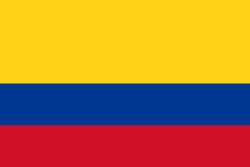Republic of Colombia
Related Categories:
 Flag of Colombia
Flag of ColombiaThree horizontal bands of yellow (top, double-width), blue, and red; similar to the flag of Ecuador, which is longer and bears the Ecuadorian coat of arms superimposed in the center. |
 Republic of Colombia - Fotw
Republic of Colombia - FotwPopular interpretations of the colours of the flag.
www.fotw.us/flags/co.html Colombia - wikipedia.org
Colombia is the 26th largest nation in the world and the fourth-largest country in South America, with an area seven times greater than that of New England and more than twice that of France.
en.wikipedia.org/
During the pre-Columbian period, the area now known as Colombia was inhabited by indigenous societies situated at different stages of socio-economic development, ranging from hunters and nomadic farmers to the highly structured Chibchas, who are considered to be one of the most developed indigenous groups in South America.
The first permanent settlement in Colombia was at Santa Marta, founded by the Spanish in 1525. Santa Fe de Bogota was founded in 1538 and, in 1717, became the capital of the Viceroyalty of New Granada, which included what are now Venezuela, Ecuador, and Panama. Bogota was one of three principal administrative centers of the Spanish possessions in the New World.
On July 20, 1810, the citizens of Bogota created the first representative council to defy Spanish authority. Full independence was proclaimed in 1813, and in 1819 the Republic of Greater Colombia was formed. The new republic included all the territory of the former Viceroyalty (Colombia, Venezuela, Ecuador and Panama). Simon Bolivar was elected its first president with Francisco de Paula Santander as vice president. Conflicts between followers of Bolivar and Santander led to the formation of two political parties that have since dominated Colombian politics. Bolivar's supporters, who later formed the nucleus of the Conservative Party, sought strong centralized government, alliance with the Roman Catholic Church and a limited franchise. Santander's followers, forerunners of the Liberals, wanted a decentralized government, state rather than church control over education and other civil matters and a broadened suffrage.
Throughout the 19th and early 20th centuries, each party held the presidency for roughly equal periods of time. Colombia maintained a tradition of civilian government and regular, free, elections. Notwithstanding the country's commitment to democratic institutions, Colombia's history also has been characterized by widespread, violent conflict. Two civil wars resulted from bitter rivalry between the Conservative and Liberal parties: The War of a Thousand Days (1899-1903) claimed an estimated 100,000 lives, and La Violencia (the Violence) (1946-1957) claimed about 300,000 lives.
www.state.gov/r/
Introduction
About
Contact
Symbols in The News
Interpret this Symbol
AAC
African
AI
Alchemy
Alphabets
Ancient
Animal Symbolism
Architecture
Art
Articles
Astrology
Baha'i
Blissymbolics
Blueprint Symbols
Buddhist
Celtic Symbols
Cemetery
Chinese Symbols
Christian
Circle
City
Codes
Color
Conlangs
Crop Circles
Danger
Da Vinci Code
Designing Logos
Dictionaries
Dreams
Education
Egyptian Symbols
Electrical
Emoticons
Find Images
Fonts
Food
Fraternity
Hamsa
Healing
Heraldry
Hermetic
Highway Signs
Hindu
History
Hobo
Holiday
Icons
iConji
Islamic
Jain Symbols
Japanese, Kanji
Jewish
Justice
Law
Literary Symbolism
Mandalas
Map
Masonic
Math, Number
Meaning of Names
Medical
Middle East
Military
Miscellaneous
Money
Music
Mythology
Native American
Playing Cards
Power
Psychology
QiQiiKhu
Reiki
Religious
Runes, Norse
Sacred Geometry
Scientific
Science Fiction
Sorority
Sports
Symbols in the News
Tattoos
ThirteenSymbols
Tree of Life
Ursprache
Videos
Visual Languages
Weather
Web Codes
Wicca
Words
Writing Systems
Braille
Coinherence
Coptic
Cuneiform
Easter Island
Etruscan
Happy Human
Hebrew
Kokopelli
Linear B
Lotus
Love Symbols
Mandorla
Moon Alphabet
Nine Pointed Star
Om
Oz
Phonetic
Scarab Beetle
Silent
Theosophy
Unifon
About
Contact
Symbols in The News
Interpret this Symbol
AAC
African
AI
Alchemy
Alphabets
Ancient
Animal Symbolism
Architecture
Art
Articles
Astrology
Baha'i
Blissymbolics
Blueprint Symbols
Buddhist
Celtic Symbols
Cemetery
Chinese Symbols
Christian
Circle
City
Codes
Color
Conlangs
Crop Circles
Danger
Da Vinci Code
Designing Logos
Dictionaries
Dreams
Education
Egyptian Symbols
Electrical
Emoticons
Find Images
Fonts
Food
Fraternity
Hamsa
Healing
Heraldry
Hermetic
Highway Signs
Hindu
History
Hobo
Holiday
Icons
iConji
Islamic
Jain Symbols
Japanese, Kanji
Jewish
Justice
Law
Literary Symbolism
Mandalas
Map
Masonic
Math, Number
Meaning of Names
Medical
Middle East
Military
Miscellaneous
Money
Music
Mythology
Native American
Playing Cards
Power
Psychology
QiQiiKhu
Reiki
Religious
Runes, Norse
Sacred Geometry
Scientific
Science Fiction
Sorority
Sports
Symbols in the News
Tattoos
ThirteenSymbols
Tree of Life
Ursprache
Videos
Visual Languages
Weather
Web Codes
Wicca
Words
Writing Systems
Braille
Coinherence
Coptic
Cuneiform
Easter Island
Etruscan
Happy Human
Hebrew
Kokopelli
Linear B
Lotus
Love Symbols
Mandorla
Moon Alphabet
Nine Pointed Star
Om
Oz
Phonetic
Scarab Beetle
Silent
Theosophy
Unifon
